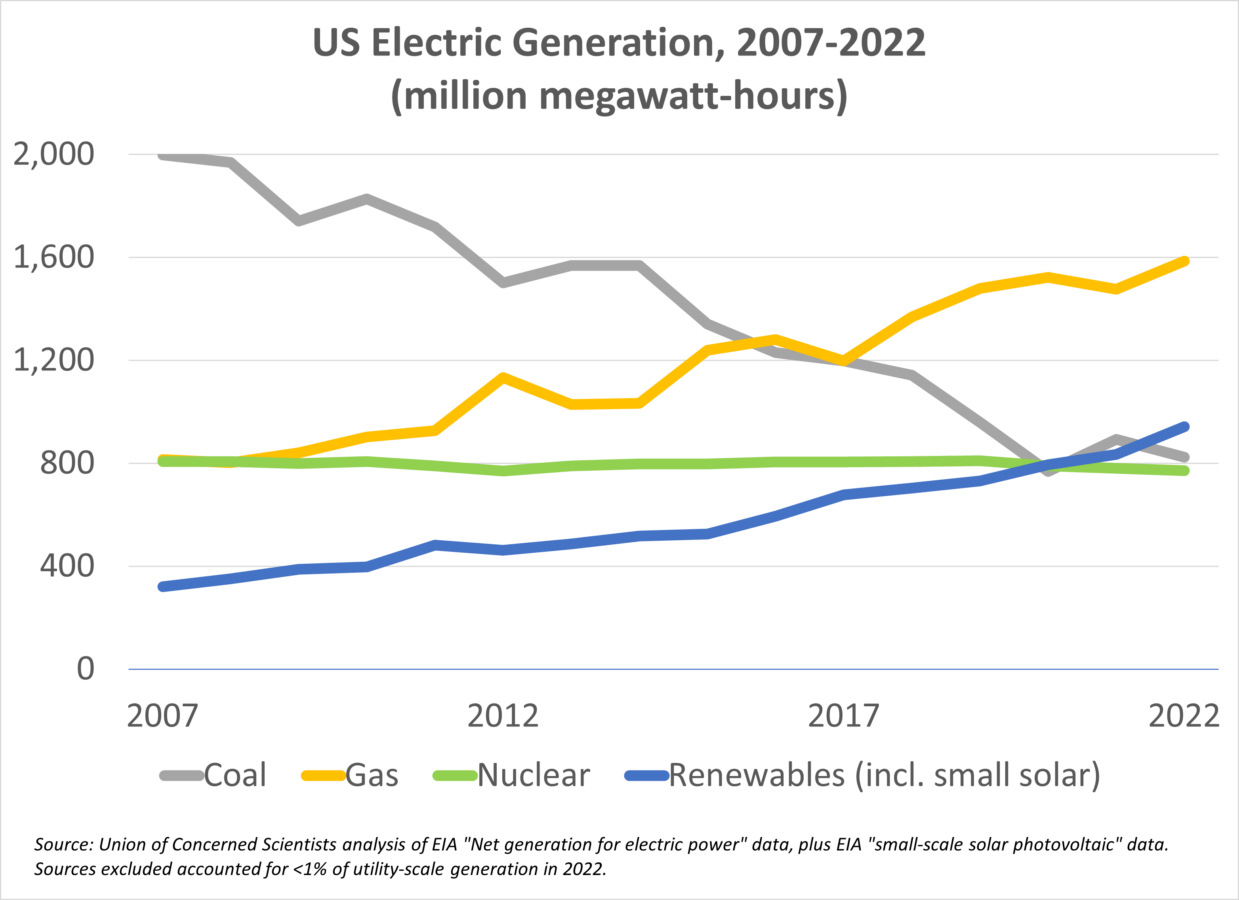There’s good news in the recently released official data on electricity generation in the United States in 2022: renewable energy has continued to grow, coal power has continued to drop, and renewables are now firmly ahead of coal for the first time ever. The numbers also have important things to say about how much more needs to happen.
The progress in the numbers
The new numbers are from the federal Energy Information Administration (EIA), which collects data from power plant operators from across the country. They offer a lot of good news about clean energy progress . Here’s a taste:
- Wind power, the largest single source of renewable electricity in the country, grew the most of any renewable energy source in overall generation from 2021 to 2022. It supplied 10.5 percent of the country’s electricity supply (up 1.1 percentage points).*
- Solar power increased the most among renewable electricity sources in percentage terms, up 24 percent. Its contribution to our electricity rose to 4.9 percent (up 0.8 points).
- Solar’s increase came from progress with both the large-scale solar featured in EIA’s topline calculations, and the small-scale solar (think panels on rooftops) that it started measuring a few years ago, when that sector got too big to ignore. Large solar provided 3.5 percent of the 2022 generation, and small solar 1.4 percent.
- With small solar included, renewable electricity all together provided 22.7 percent of US electricity, up 1.9 points from the year before. Wind, hydroelectric, and solar power accounted for 95 percent of renewables’ 2022 generation.
Renewables up, coal down
More renewable energy is desirable for a lot of reasons. Some of those, such as the public health and climate benefits, depend on the clean energy displacing the dirty stuff—avoiding increases in fossil fuel generation or, even better, displacing existing generation. From a public health perspective, displacing coal is particularly important.
So it’s good news that the 2022 numbers also show coal generation dropping, and renewables clearly surpassing coal. Renewables (including small solar) had squeaked past coal in 2020, before a rebound put coal back on top the following year. But, in 2022, renewables generated 14 percent more than coal, as renewables rose and coal fell (7.7 percent). That crossover is consistent with the long-term trend for both renewables and coal: renewable generation increased every year of the last decade, while coal dropped in seven of those years.

These improvements didn’t happen by chance
The numbers show progress, but they also testify to the power of the policies that have helped drive the clean energy transition—policies such as federal air and water pollution protections, federal and state tax credits for clean energy, and state renewable electricity standards and clean energy standards. These policies have helped increase focus on renewable energy which, in turn, has helped drive down the costs of renewables.
In particular, the economics of wind and solar, are such that renewable energy is now often the cheapest option for new power capacity (and cheaper even than existing coal power plants). That means, all else being equal, economics can increasingly drive their adoption.
But all else is not equal, and just as those improvements didn’t happen by themselves, further progress isn’t automatic. Entrenched fossil fuel interests, disinformation about climate change and clean energy, and outdated electric grid rules and practices all make continued progress on the policy front essential to our continued progress replacing fossil fuels with clean energy in the power sector.
That progress in both numbers and policies is indispensable. One reason is climate change, and the increasingly dire news on that front. Another is the areas of continued concern that the 2022 generation data reflect. Coal generation, while down last year and down from 40 percent of total generation a decade ago (and 50 percent just a few years before that), still accounted for almost 20 percent of the electricity generated in the United States last year. Gas generation, after dropping in 2021, bounced back to its highest level yet in absolute terms, and accounted for 38 percent of US supply.
Keep it coming
So, a major takeaway is that we need continued attention on the factors critical for clean energy progress. That means more attention to community perspectives on siting new electricity generating capacity and on the clean energy transition (including for communities and workers moving away from fossil fuels); increased focus on public health; more progress on the technologies, the economics, and the policies driving the change. We need to live into the promise of laws like the federal Inflation Reduction Act and the leadership of states that are showing the way. And we need strong federal power plant carbon rules (plus strong implementation by the states).
But we also need to celebrate the progress we do make, and what’s coming because of the groundwork we’ve laid. As the latest numbers suggest, there’s a lot of momentum in favor of clean energy. And EIA is projecting coal to lose more ground in 2023 (dropping three percentage points), and gas to fall in 2024 (two percentage points), while renewables rise two percentage points in each of this year and next. That growth in renewables isn’t the 4-5 percent per year we need to see to reach 80 percent low-carbon electricity by 2030 and 100 percent by 2035. But it is a solid foundation to build on.
The latest data on US electricity generation show real progress on the clean energy transition. Understanding how we got here and what more needs to happen will help us make sure the numbers keep getting even better in the years ahead.
*Electricity generation calculations in this post reflect the inclusion of small-scale solar in the denominator.

